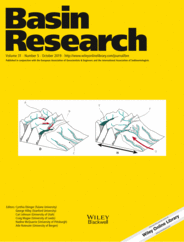
Full text loading...
 , George D. Jones3, Rufus L. Brunt2, Daniel E. Tek4, David M. Hodgson4, Stephen S. Flint2
, George D. Jones3, Rufus L. Brunt2, Daniel E. Tek4, David M. Hodgson4, Stephen S. Flint2
Exhumed basin margin‐scale clinothems provide important archives for understanding process interactions and reconstructing the physiography of sedimentary basins. However, studies of coeval shelf through slope to basin‐floor deposits are rarely documented, mainly due to outcrop or subsurface dataset limitations. Unit G from the Laingsburg depocentre (Karoo Basin, South Africa) is a rare example of a complete basin margin scale clinothem (>60 km long, 200 m‐high), with >10 km of depositional strike control, which allows a quasi‐3D study of a preserved shelf‐slope‐basin floor transition over a ca. 1,200 km2 area. Sand‐prone, wave‐influenced topset deposits close to the shelf‐edge rollover zone can be physically mapped down dip for ca. 10 km as they thicken and transition into heterolithic foreset/slope deposits. These deposits progressively fine and thin over tens of km farther down dip into sand‐starved bottomset/basin‐floor deposits. Only a few km along strike, the coeval foreset/slope deposits are bypass‐dominated with incisional features interpreted as minor slope conduits/gullies. The margin here is steeper, more channelized and records a stepped profile with evidence of sand‐filled intraslope topography, a preserved base‐of‐slope transition zone and sand‐rich bottomset/basin‐floor deposits. Unit G is interpreted as part of a composite depositional sequence that records a change in basin margin style from an underlying incised slope with large sand‐rich basin‐floor fans to an overlying accretion‐dominated shelf with limited sand supply to the slope and basin floor. The change in margin style is accompanied with decreased clinoform height/slope and increased shelf width. This is interpreted to reflect a transition in subsidence style from regional sag, driven by dynamic topography/inherited basement configuration, to early foreland basin flexural loading. Results of this study caution against reconstructing basin margin successions from partial datasets without accounting for temporal and spatial physiographic changes, with potential implications on predictive basin evolution models.
,Unit G from the Laingsburg depocentre (Permian Karoo Basin, South Africa) is a rare example of a complete basin margin scale clinothem, with depositional strike control, which allows a quasi‐3D study of a preserved shelf‐slope‐basin floor transition. Unit G is interpreted as part of a composite depositional sequence that records a change in basin margin style from an underlying incised slope with large sand‐rich basin‐floor fans to an overlying accretion‐dominated clinoforms with limited sand supply to slope and basin‐floor.

Article metrics loading...

Full text loading...
References


Data & Media loading...

